"Pete the Cat: Rocking in My School Shoes": Accessible Ideas for Children with Multiple Disabilities
Submitted by Jstarks on Apr 25, 2017

As part of the graduate coursework for Visual Impairments and Multiple Disabilities in the Teacher Preparation Program in Visual Impairments at the University of Kentucky, students were asked to complete four projects: Story Box, Picture Communication Symbols for Story Box, Tactile Communication Symbols, and Talking Book Project.
We are sharing them on Paths to Literacy and hope that others will use them! Please add your comments at the bottom of the page. This project is based on Pete the Cat: Rocking in My School Shoes by Eric Litwin.
Pete the Cat: Rocking in My School Shoes by Eric Litwin, illustrated by James Dean, is another adventure in a series of early elementary level books featuring Pete the Cat. In this adventure, it's Pete the Cat's first day of school and he's wearing his awesome school shoes, which take him all over the school. Pete discovers the library, the lunchroom, the playground, and lots of other cool places at school. But he knows he has nothing to worry about, because he's ready for anything in his school shoes! Instead of worrying, Pete sings a song about what he’s doing in his school shoes and decides that school is pretty cool. I chose to make this book accessible because it is often used at the beginning of the school year along with activities designed to introduce students to the various locations in their own school. Also, many children love the song portion of the book and will sing it, so it encourages student engagement.
This book had a Lexile level of AD600L and is intended for grades Pre-K through grade 2. To make the book more accessible to students with multiple disabilities and/or visual impairments, I have supplemented the book with tactile objects that the students can explore.
Story Box
Objects in the Story Box:
The following is a list of the items and an explanation for why each item was selected:
- Backpack – Since the story is intended for elementary students, most of the students will associate a backpack with going to school. Pete the Cat also has on a backpack in the story. The backpack is also a convenient way to store the other items used for this story adaptation.
- Guitar – Pete the cat takes a guitar with him to school and uses it throughout the story to sing his song.
- Pete the Cat plush – He’s the main character and a plush is used since Pete the Cat is a fictional cartoon cat who often stands on two feet like a human.
- Shoe – Pete the Cat is confident wearing his school shoes. This item was selected as a main feature of the story. It allows the student to feel the shape, material, and strings of a shoe.
- Children’s book – One place Pete goes is the library where he chooses a book and sings about reading.
- Lunchbox – Pete also goes to the lunchroom to eat. This style of lunchbox was chosen for the story box because it is the style children would most likely be familiar with. The type of lunchbox that Pete uses in the story is an older style and would be more familiar to adults than to children.
- Milk carton and fork – These two items are in the lunchbox and were chosen to represent an image of Pete at lunch in the story. In one image, Pete is seen holding up a carton of milk in one paw and a fork in the other.
- Plastic coated chain – This object is the type of safety chain used on children’s swings. It was chosen since it would be the part of a swing that a child would hold while swinging.
- Paintbrush – This object is the type of paintbrush children use for art. Pete the Cat does many activities at school including painting. I chose a yellow paintbrush to make it easier to see for a student that may have CVI.
- “Abacus” (actually, a homemade counter using beads on a pipe cleaner) – Pete the Cat is adding and all of his numbers in the illustration are less than 10, so I chose to include a bead counter rather than a full-size abacus to represent math. I have seen these types of counters used in preschools so it may be familiar to the children.
- Pencil – Pete the Cat also spends some time writing at school. A pencil would represent writing for elementary students.
- Large piece of brown, rough textured vinyl (12”x12”) – This material was chosen to represent a school bus. It has the same texture and feel that a school bus seat has. It is not practical to include a real school bus in an activity, so I selected a part of the school bus that the children would most likely be familiar with.
- Finally, a miniature electric guitar – just for fun, I selected to give the Pete the Cat plush his own guitar.
Background knowledge students may need to understand the items:
Although most of the objects in this story box are school-related items (except for the guitar and the Pete the Cat plush), Pete the Cat: Rocking in My School Shoes is often presented to students at the beginning of the school year, so the students may not yet be very familiar with many of the objects. The objects should be pre-taught so that students understand what each object represents. For example, a guitar is a musical instrument, a pencil is for writing, a bead counter is for numbers (or adding or math, whichever term the student would most likely know), a library has books, etc. They would also need to be taught some key vocabulary such as:
- Strolling- walking
- Rocking- swaying back and forth to a beat or just being awesome
- Library – a room with lots of books
- Lunchroom – a place to eat with long tables
- Playground – an outdoor area for playing
Strategies for implementing the Story Box:
- Make a prediction of subject - Before reading, the objects can be offered to students to explore and make predictions on what they think the story is about.
- Vocabulary - Before reading, after students have made predictions, present the objects one at a time and introduce the key vocabulary. Discuss how understanding key vocabulary words will help to better understand the story (comprehension).
- Story supplemental - During reading, present the objects as they appear in the story. Allow time for the student to explore the object while it is presented in the book.
- Make predictions of setting - During reading, the students can use the objects to predict where Pete is. For example, when presented the fork and the text says “long tables and lots of seats”, the student can predict that Pete is in the lunchroom.
- Story sequencing - After reading, the objects can be presented to student (number of objects presented at one time would depend on student needs) and the student can sequence story events.
- Re-reading strategy with student interaction - Re-read the story and during reading, give each student a different object. When the story gets to their part, the student will present his/her object.
- ELA standards for theme and expressions - After reading, discuss rhyme and repetitive patterns in books (wherever Pete goes, he sings a variation of the same song. Objects could be used to show the variations of the repetitive pattern, i.e. reading, painting, adding, eating). This book can also be used to focus on reading with expression and paying attention to punctuation marks. There could be a discussion about the theme of the story that is presented at the end – don’t worry “it’s all good”. Common Core: Students can discuss the theme of the story (RL 1.2) or identify parts of the story which denote different expressions of feelings (RL 1.4).
- Social Studies - After reading, the objects can be used to introduce exploration of the student's school. Choose a target location and hide the Pete the Cat plush in that room. Then, give a clue via objects. One example would be, when the object “book” is presented, ask the students where Pete went that had “books on every wall”. When they reply “library”, take them to the library and allow time to explore and try to find Pete. Encourage students to use their O&M skills to navigate their way around the room. Give verbal hints as to where Pete might be hiding, if needed. You can then teach the rules of each area and hallway.
- Comprehension - After reading and other reinforcement activities, students can use the objects to answer comprehension questions. The objects will possibly help them understand and transition to the tactile communication cards.
Tactile Symbols
Tactile communication symbols were chosen to correspond to the objects in the story box. Many of the symbols are portions of the same objects. I have mounted the objects on tactile communication cards that came in a kit from APH. Different colors and shapes represent different categories. Each card has a 20 pt Arial font large print label as well as a braille label to make the symbol more accessible to students with visual impairments. The communication symbols are stored in a 3-ring binder with Velcro sticking them to felt covered matte board. There are 14 tactile symbols in this set. Two of the symbols in the image had a glare from the sun which made them appear to not have labels. The white card with the chain says “swing” and the white card with the shoelace says “shoes”.
Each symbol was chosen to represent a specific part of the story. The following list describes each symbol and why it was chosen.
- Pete the Cat – A yellow card with a crown shape representing the category “people” was chosen because Pete is the main character of the story. He is a cartoon cat that has many human behaviors. The symbol is a patch of blue felt that feels like the plush Pete the Cat from the story box with hemp strings (3 on either side) to represent Pete’s whiskers.
- Shoes – A white card with a rounded convex top was used to represent the category of “object”. A shoestring is used to represent shoes since that would be a recognizable part of the shoe.
- Rocking – A green card with a triangular top representing the category “action”. The symbol is a yellow foam sheet background with raised beading wire to represent guitar strings. This was chosen because when the student touches the symbol, it feels the same as touching the front of the guitar that was used in the story box when Pete was “rocking”.
- Library – A red card with a barn shaped top to represent the category “place”. The symbol is a small “book” made per the guidelines in the APH Tactile Connections Guidebook.
- Reading – This is the same symbol as the library symbol (a small “book”), but it is attached to a green card with a triangular top representing the category “action”. This symbol was also selected per APH Tactile Connections Guidebook to standardize symbols.
- Lunchroom - A red card with a barn shaped top to represent the category “place”. This symbol was also selected per APH Tactile Connections Guidebook to standardize symbols. It is the bowl part of a spoon with yellow puffy paint in the center.
- Eating - A green card with a triangular top representing the category “action”. The symbol used for eating does differ from the APH Tactile Connections Guidebook to better represent this story. The symbol chosen is the top part of a fork because Pete has a fork in the book and a fork is used in the story box.
- Swing – A white card with a rounded convex top was used to represent the category of “object”. The symbol is a smaller piece of the plastic covered safety chain used in the story box. It was chosen because it would be the part of a swing the child holds onto when swinging and would be a familiar texture. I did not choose to make this an action because when Pete and his friends are on the playground where there are swings and a slide, Pete sings about playing rather than swinging.
- Painting - A green card with a triangular top representing the category “action”. This symbol was also selected per APH Tactile Connections Guidebook to standardize symbols. Although the guidebook uses it to represent “Art”, Pete sings about painting. It is a portion of a child’s paintbrush mounted vertically with the bristles up.
- Adding - A green card with a triangular top representing the category “action”. The symbol is a smaller version of the bead counter used in the story box. It has 3 brightly colored beads that are mounted on a pipe cleaner. This symbol was chosen because many elementary children use bead counters in their classrooms and the beads would be a familiar texture.
- Writing - A green card with a triangular top representing the category “action”. The symbol is a sharpened pencil which includes the eraser because pencils are associated with writing.
- Bus – A white card with a rounded convex top was used to represent the category of “object”. A small piece of the same brown vinyl that was used to represent “bus” in the story box is mounted to the symbol card. This texture was chosen because a student is most likely to be familiar with the texture of a seat on the bus.
- Tomorrow – A blue card with a rounded concave top was used to represent the category “time”. The symbol is a piece of thin rope mounted vertically and a star shaped gem to the right of it. This symbol was selected per APH Tactile Connections Guidebook to standardize symbols.
- All good – A black rectangular card was chosen to represent the category of “expression”. The symbol is googly eyes and a pipe cleaner bent in the shape of a smile. This symbol was chosen because of its similarity to happy which is the same symbol, but on a grey emotions card. If everything is all good, the person is happy.
Questions for students to answer using tactile communication symbols:
- Who is the main character of the story? Or, who is the story about? (Pete the Cat)
- What is Pete wearing on his four furry feet? (school shoes)
- Pete plays his guitar and sings his song. What does Pete sing that he is doing in his school shoes on his way to school? (rocking)
- Pete is going to a room with books on every wall. Where is Pete going? (library)
- What was Pete doing in the library? (reading)
- Pete is ready to eat in a big noisy room with tables and seats. Where is Pete? (Lunchroom)
- Pete is in the lunchroom and sings his song. What does he sing about doing in in school shoes? (Eating)
- There is a slide on the playground. What else is on the playground? (Swings)
- What are some other activities that Pete does in his school shoes? (painting, adding, writing)
- How did Pete go home? (bus)
- When will Pete go to school again? (tomorrow)
- How did Pete feel about school? (It’s all good)
Implementing an Activity:
After reading the story to the student or letting him/her listen to the story via the Pete the Cat: Rocking in My School Shoes talking book, the student would be able to use these communication symbols to answer questions, sequence the story, and explore object categories.
Symbols can be presented to the student in a variety of ways. There is Velcro on the front of the binder the symbols are stored in for quick reference activities. If presented along with the story box, there is Velcro on the front of the backpack where the symbols could be presented. Another option is to use a carpet floor mat and Velcro the symbols to it, but be aware that the symbols stick very well to it and the student may need some help removing symbols. These options provide a black or dark navy blue (backpack) background to improve contrast and limit visual clutter.
The teacher would ask the 12 questions, one at a time, and let the student choose a symbol for the answer, referring to the story as needed. The number of symbols presented to the student to choose from would be individualized based on student need.
Then, 3 or more symbols, depending on student needs, would be presented for the student to sequence story events. For example, where did Pete go first? Then, where did he go? The student would place the cards in the correct order. To work with categories, the student could put most of the cards under headings: action (or -ing words), places, and things.
Other activity options would be the same as those presented in the story box such predicting activities and exploring the students’ school to locate the same areas/activities that Pete the Cat experienced.
Picture Symbols
Picture communication symbols were chosen based on the events in the book Pete the Cat: Rocking in my School Shoes by Eric Litwin. Picture symbols were chosen and used for each character, location, and activity that Pete the Cat encounters on his adventure in his school shoes. These include picture symbols for the following (symbol in parenthesis) and explanations, if needed:
- Pete the Cat (Pete)
- Strolling (image from text - Pete walking)
- school shoes (high top red shoe) – Pete is wearing red shoes in the story.
- rocking (electric guitar) – electric guitars are associated with rock music.
- Teacher (Pete’s teacher)
- library (Boardmaker - book in building) – standard symbol for library
- Reading (Pete holding book and reading)
- lunchroom (table from text)
- Eat (fork) – Pete has a fork when in the lunchroom.
- playground (image from internet - slide and swing) – reduces visual clutter
- Playing (Boardmaker–boy on swing)–Pete is on a swing when he sings “playing in my school shoes” and this reduces visual clutter
- Singing (image from text – Pete and friends with music notes)
- painting (art paintbrush)
- Adding (abacus) – Used in math, but student may need to be taught this symbol since the story box and tactile symbols use bead counters.
- Writing (pencil)
- School Bus (profile of school bus)
- Pete’s Mom (image from text of Pete’s mom)
- All Good (Thumbs up symbol) – Thumbs up generally means all is good.
Two formats of picture communication symbols were created using the same 18 pictures. One format is a layout to be compatible with a GoTalk9+ and the other format is individual picture symbols that have been laminated and have Velcro on the back. Each symbol has an 18pt Tahoma font print label with black letters on a white background to make the print on the symbol more accessible for students with visual impairments. All images have also been made more accessible to students with Cortical Visual Impairments (CVI) by reducing visual clutter and modifying the symbol backgrounds to red or yellow. A couple of symbol backgrounds were changed to black to increase contrast. One set of picture communication symbols are stored in the GoTalk9. The individual picture communication symbols are stored in a 3-ring binder with Velcro sticking them to felt covered matte board.
Questions for students to answer using picture communication symbols:
- Who is the main character of the story? Or, who is the story about? (Pete the Cat)
- What is another word for walking? (Strolling)
- What is Pete wearing on his four furry feet? (school shoes)
- Pete plays his guitar and sings his song. What does Pete sing that he is doing in his school shoes on his way to school? (rocking)
- Pete is going to a room with books on every wall. Where is Pete going? (library)
- Who sent Pete to the library? (Teacher)
- What was Pete doing in the library? (reading)
- Pete is ready to eat in a big noisy room with tables and seats. Where is Pete? (Lunchroom)
- Pete is in the lunchroom and sings his song. What does he sing about doing in in school shoes? (Eat)
- Where are there swings and a slide? (playground)
- What does Pete sing about doing on the playground? (playing)
- What are some other activities that Pete does in his school shoes? (painting, adding, writing)
- How did Pete go home? (school bus)
- Who asks Pete about his day at school? (Pete’s mom)
- How did Pete feel about school? (It’s all good)
- What are some of the things Pete does that you also do at school? (any activity)
- What do you like to do at school? (any of the activities)
Implementing an Activity:
After reading the story to the student or letting him/her listen to the story via the Pete the Cat: Rocking in My School Shoes talking book, the student would be able to use these communication symbols to answer questions, sequence the story, discuss the story, and match activities to locations.
If using the GoTalk9 communication device, the first 9 symbols are on level 1 and the second 9 symbols are on level 2. The core vocabulary on both levels is Pete the Cat, rocking, and school shoes.
If using the individual picture symbols, they can be presented to the student in a variety of ways. There is Velcro on the front of the binder the symbols are stored in for quick reference activities. If presented along with the story box, there is Velcro on the front of the backpack where the symbols could be presented. Another option is to use a carpet floor mat and Velcro the symbols to it. These options provide a black or dark navy blue (backpack) background to improve contrast and limit visual clutter.
For comprehension application, the teacher would ask the first 15 questions, one at a time, and let the student choose a picture symbol for the answer, referring to the story as needed. The last 2 questions are to encourage discussion of the story. The number of symbols presented to the student to choose from would be individualized based on student need.
Then, 3 or more symbols, depending on student needs, would be presented for the student to sequence story events. For example, where did Pete go first? Then, where did he go? The student would place the cards in the correct order or press the correct order on the GoTalk9 (easy since I printed them in order).
Finally, the student can use the picture symbols to match locations with activities. Again, this would be modified depending on student ability. One option would be to place all the location symbols (library, lunchroom, playground) on the left of the work area and the activity symbols (reading, eating, playing) on the right. If the student is able, other activities can be thrown in as distractions (singing, painting, adding, writing). Another option for students with lower abilities would be to present only one location (or one activity) at a time and have the student select the matching activity (or location) out of a choice of two or three options.
Other activity options would be the same as those presented in the story box such predicting activities and exploring the students’ school to locate the same areas/activities that Pete the Cat experienced.
Talking Book Project
Because of copyright law, we are unable to share the link to this.
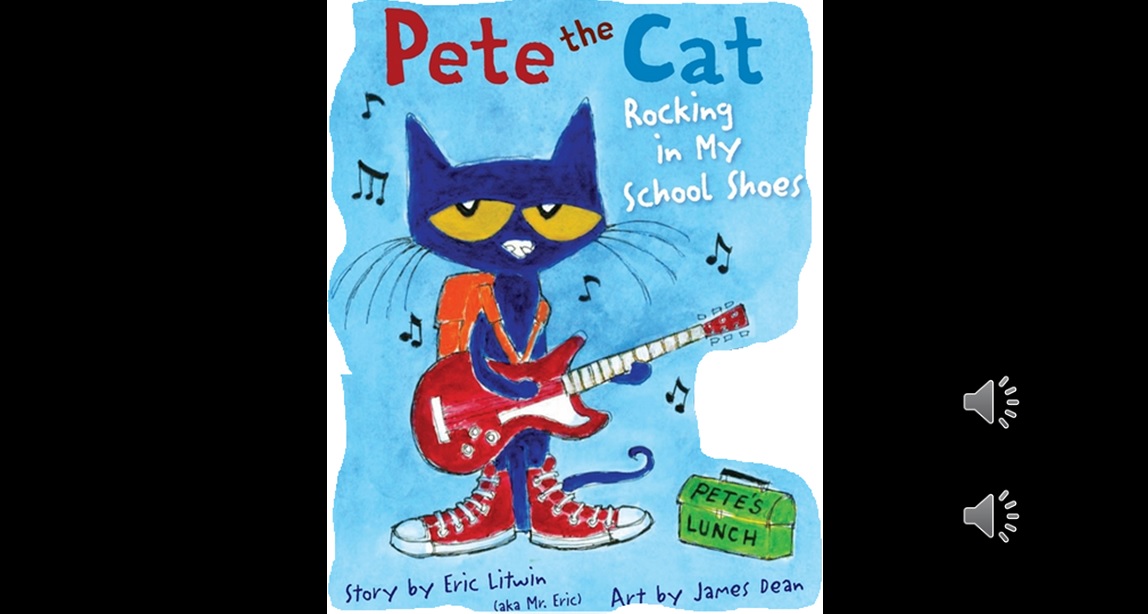
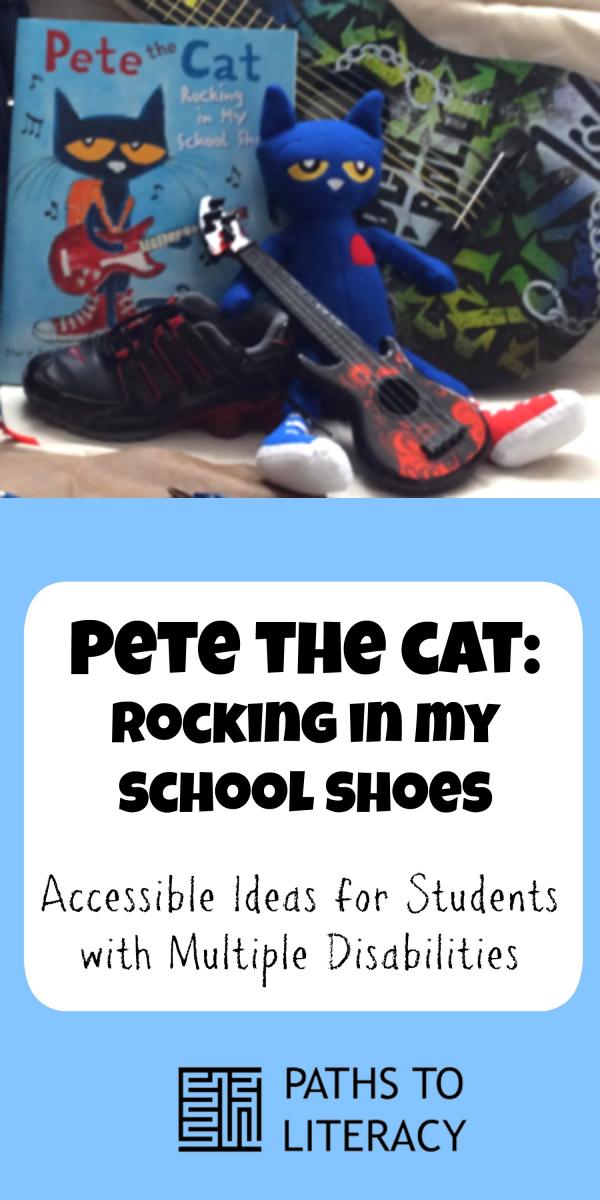

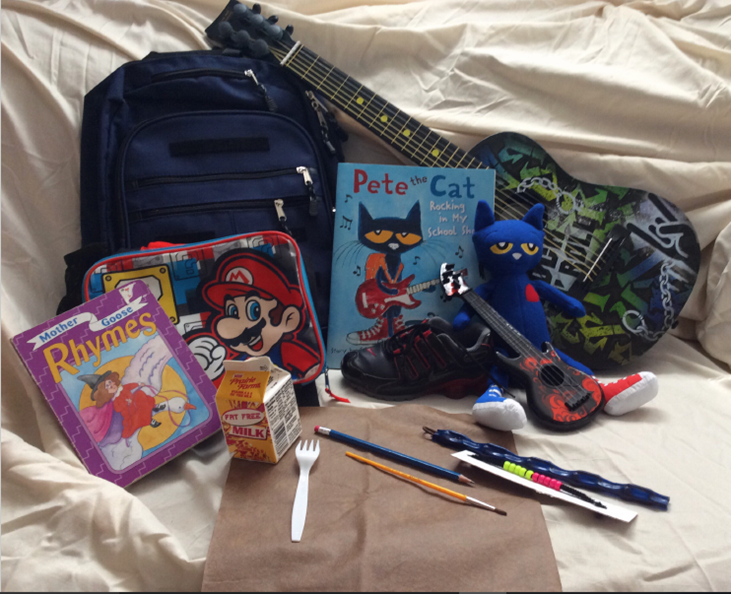
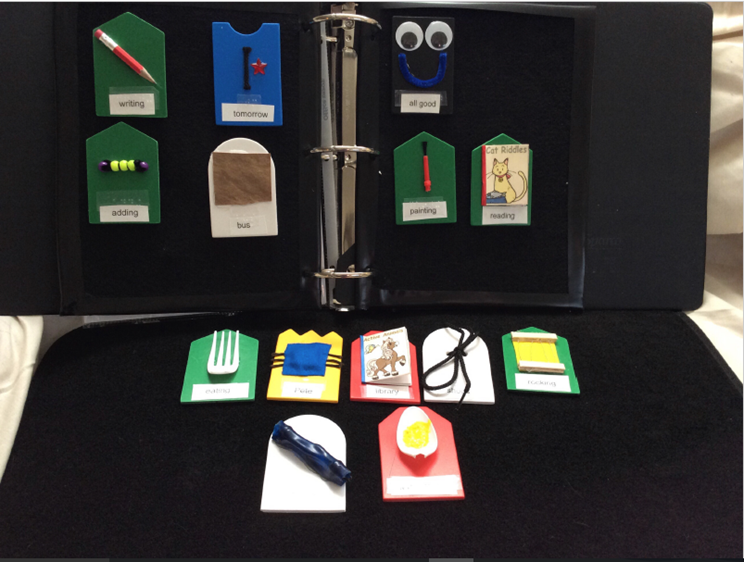
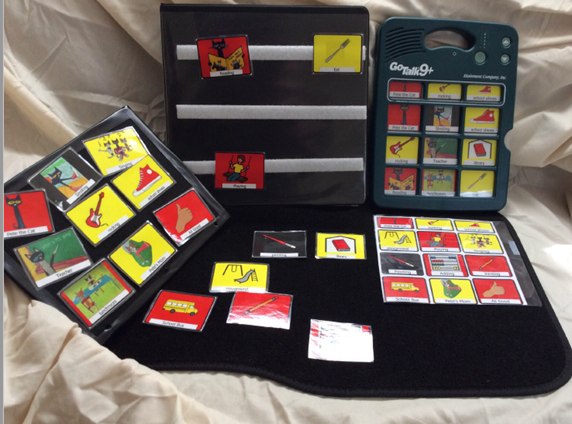
Comments
Pete the Cat